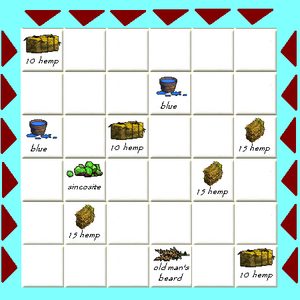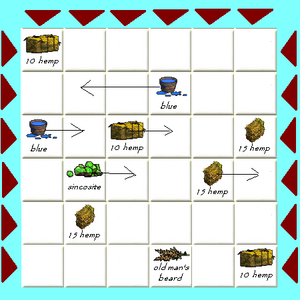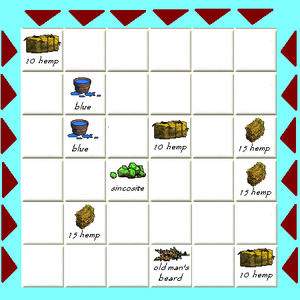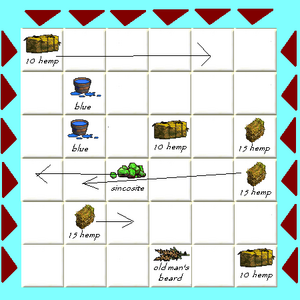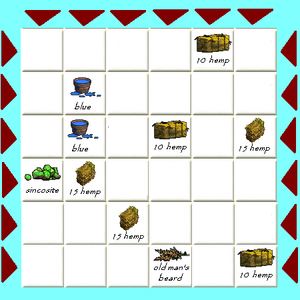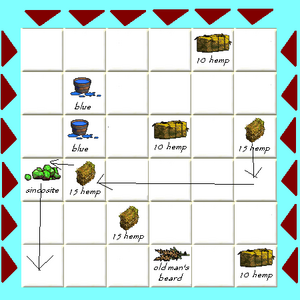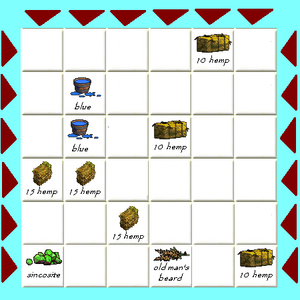GCPP:Proposal-Tench
Puzzle Codename: Tench
| Contact | |
| Username: | Tcarr |
| Additional contact info: | Please contact mournful regarding the contest entry version and the current puzzle implementation. |
| Project forum thread: | Forum discussion |
Game concept
Arrange commodities in a column to make the target recipes listed in the chat tab.
Quick Start
Arrange commodities in a column using the one-way conveyor belts to make the target recipes listed in the chat tab. The commodity pieces must add up to exactly 1x, 2x, or 3x the recipe and be placed consecutively in a column starting from the bottommost board square to count towards a recipe. Click on the green Tench! button in the lower righthand corner to make a play. When a play is made, the game scores the column recipes from left to right. It displays the matched recipes in the chat box and drops new pieces from the top.
Scoring
Scoring is based on the number of commodity pieces used to make a recipe. Multiple recipes can be put in a column if they are separated by one row. Making recipes in consecutive columns gives an increasing multiplier to recipe in higher consecutive columns. Any recipe in the industry may be matched, including recipes not listed in the target recipes. The base score for making a non-target recipe is 0. Recipes may be chained across plays by matching a target recipe using the same column in the next play. Matching a target recipe in the column matching it's number gives a bonus (not done in the contest version is a target recipe display below each column on the board where this would be logical to give a score bonus for matching the target recipe in the column that it is displayed in). Columns are numbered starting from 1 and from left to right.
Objective
Create chains of recipes in consecutive columns or across plays. Use more commodity pieces in a recipe and make target recipes to increase your score.
Gameplay
Seven vertical columns (the conveyor belts) have various commodities relevant to the industry scattered on them, with some empty spaces as well. Each location on a belt can only hold one commodity. Clicking at the top of a belt moves each commodity down one space, except that when one hits the bottom, commodities start piling (and not moving). Clicking at the right or left moves each commodity in a row similarly. Commodities will not fall off the edge.
New pieces drop from the top of a column and are partially shielded by having a piece high in the column, with an increasing effectiveness based on the difficulty level. Higher difficulty levels will tend to get more special pieces and more pieces. Normally a target recipe is replaced when it is matched. It will not be replaced if the target recipe is matched in the column number corresponding to the target recipe number. This is intended to be used to save a favorable target recipe for use in the next play and to make chained plays easier.
At the bottom, you see small images of recipes that could be made with tiles currently on the board. (Not implemented.) You do not have to put the commodities in the same order, just in the same vertical column.
When you finish arranging commodities, click the lower right button.
Columns with valid recipes are cleared. New commodities are dropped from the top of the board. Play continues until 12 recipes are made. In the final round, all valid recipes are counted towards the score. The player may make up to 18 recipes, 11 recipes from previous plays and 7 recipes in a single play.
Able Albert just wants to do able labor as fast as possible. For a weavery, he could shove everything except hemp over as far as possible. Put one bale of hemp on each column, with nothing else, and he gets a tan cloth combo which is good enough for Able if it is at least three batches. Other industries would not have such super-easy recipes possible.
Storyboard (Not updated)
This is an example of an Able level board for the weaving industry. Below the board would be displayed representations of the recipes for Aqua (10 hemp, 1 blue, 1 sincosite), Blue (10 hemp, 1 blue), Fine Blue (15 hemp, 2 blue), Brown (10 hemp, 1 OMB), Tan (10 hemp) and Fine Tan (15 hemp). On the board we see 3 sets of 10 hemp, and 3 of fine hemp, 2 blue dye, 1 sincosite, and 1 OMB.
There are several possible ways to play this board. Do we try to move both blues into one column with a 15-hemp, or keep them in separate columns with 10-hemps each? If we use the OMB, then it needs a 10-hemp. If we use the sincosite, it needs a 10-hemp and one blue.
Rylla decides to make fine Blue on the second conveyor belt. That needs 2 blue and a 15-hemp. She clicks the arrows on the sides to move the items into place. Now the board has Tan (1 point), Fine Blue (3 points), booch (zero), Brown (2 points), booch, and booch. Let's try to get one or two more recipes finished. Hmmm......
Rylla is getting a headache is sorely tempted to just click the Done button and take her Triple. She takes a deep breath and tries to think creatively. Maybe.... oooo maybe this will work! She clicks the arrow to the right of the row that the sincosite is on several times, so that the 15-hemp is in the column with the two blue. There are now two empty columns, and two rows with just hemp in them, so it is easy to move one bale of hemp to each of the empty columns.
Rylla clicks the top bar, making (booch), Fine Blue, Fine Tan, Brown, Tan, (booch), to get a Bingo. If she had more experience, she might have noticed this possible extra set of moves to make a Donkey. First, move the sincosite down to the bottom. Whatever column that's in will be a booch. Next, move the far right column down one. Finally, move the 15-hemp from the far right column all the way over, so that it is under the 2 blue dyes. This gives one extra Tan. A similar set of moves could probably be used to give an extra Fine Tan instead, but since the points for Tan and Fine Tan are the same, it isn't worth the effort.
A progress bar of some kind moves up one notch for each recipe completed. When it reaches the top (12 recipes), the session finishes. Since Rylla has only done one board, the columns that are completed recipes are cleared, and the commodities in the booch columns are shoved to the bottom. Enough extra random commodities are added to the board to meet the quota for Rylla's difficulty level, and a new set of recipes appears.
Scoring
One point for each commodity in the first filled recipe. Two points for each in the second filled recipe. Three points for the third one, etc. The game calls the least valuable recipe the "first" one. No penalty for columns that do not have legal recipes, as long as at least one column does. No legal recipes constitutes a booch, and points are lost (one for each commodity on the board).
Variability
Higher levels will have more commodities and more variety of commodities on the belts. This makes arranging them more difficult, but allows for higher scoring recipes with bonuses on minerals, dyes, and herbs. One possible special commodity piece is a wild card; the first time it would move into another commodity, it turns into that commodity (which may or may not be useful). Another special commodity piece is a bomb; the first time it would move into another commodity, it explodes and both disappear.
End criteria
12 filled recipes ends the game. Higher level players will likely strive to finish one combo just under the goal, so that they get the maximum number of overtime recipes.
Difficulty scaling
Higher levels have more variety of commodities on the belts. This makes the puzzles harder, but allows for higher scores if the player makes recipes with those commodities.
Crafting type
Any industry should work.
Known problems
Notes
Initial version of the game will use a subset of recipes from one industry, such as weaving or furnishing, and could very well use simple generic images for the commodities. If the game turns out to be fun to play, then we can choose an industry and code the actual recipes (or a subset, since there are far too many furniture recipes).
Images
Images can be made after the industry is decided. We would need one tile face for each commodity used by the industry, plus wild card, bomb, and empty. We would need smaller size images of each commodity, for displaying the recipes.
